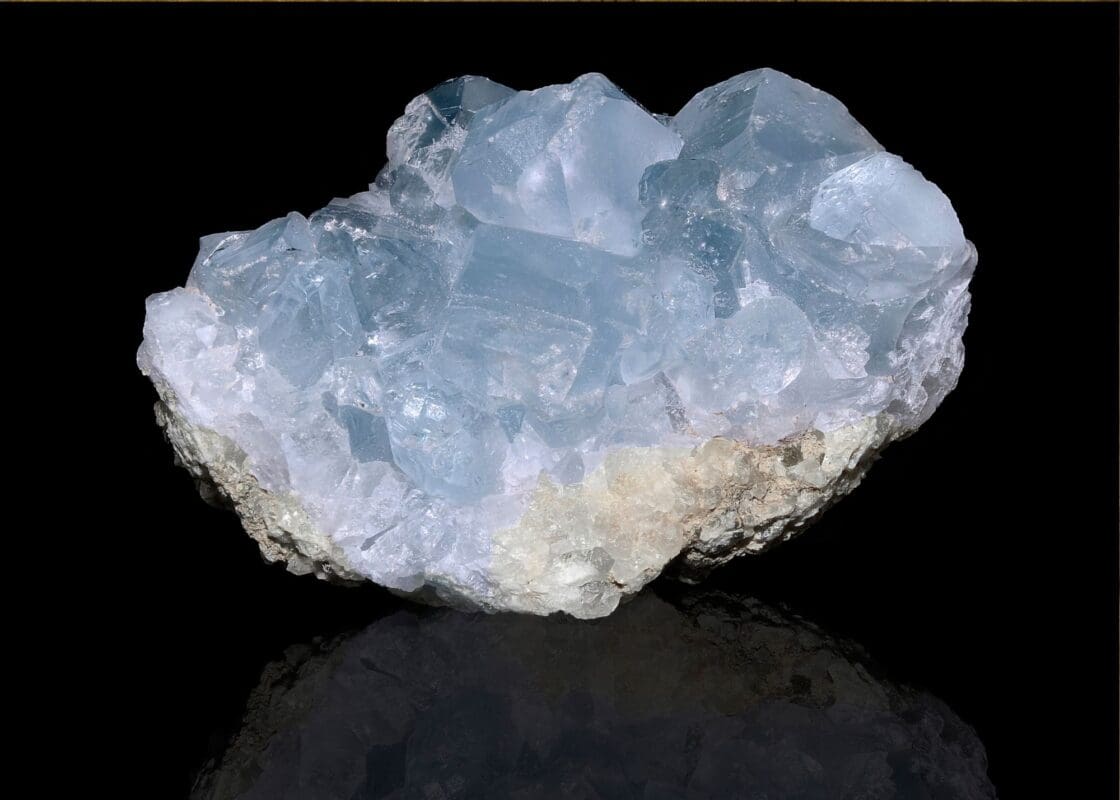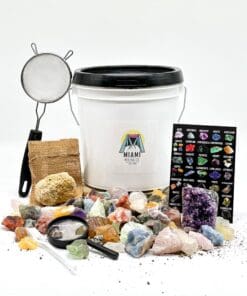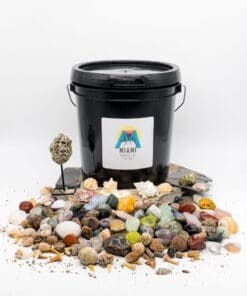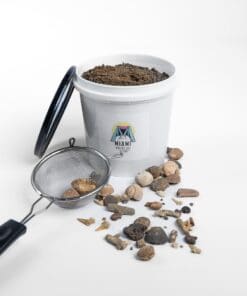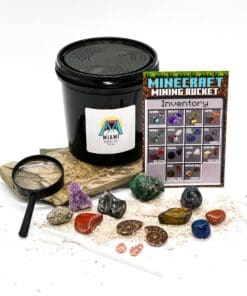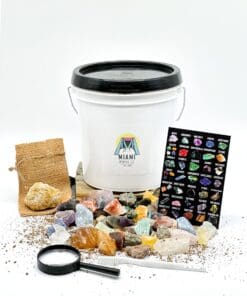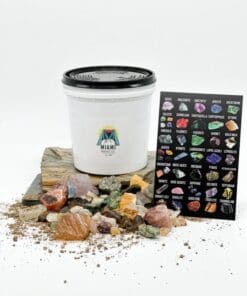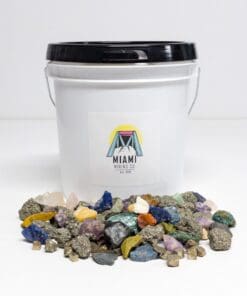Gem Mining Ohio Revealed: Digging Deeper into the State’s Glistening Treasures
Ohio, with its rich geological history and vast landscapes, is a haven for gemstone enthusiasts. The appeal of gem mining lies in the thrill of discovery, connecting with the earth, and the potential for valuable finds. This article provides an in-depth look into Ohio’s gem mining culture, highlighting the types of gemstones you can uncover, popular mining locations, and so much more.
The Most Popular Gemstones in Ohio
Ohio’s diverse geological landscape has fostered the presence of a myriad of gemstones. Ranging from the rather common to the exceptionally rare, these stones not only signify the state’s rich earth but also its cultural heritage. Here, we’ve categorized these gemstones based on their rarity and prevalence in Ohio.
Rare Gemstones in Ohio:

| Gemstone | Description |
|---|---|
| Celestite | A sky-blue mineral known for its stunning crystal formations, often found in the northwestern parts of Ohio. |
| Gold | While not a typical find, gold flakes have occasionally been discovered in Ohio’s rivers and streams. |
| Pyrite “Fool’s Gold” | Not as valuable as real gold, but its shimmering, golden appearance attracts many collectors. |
| Barite | A heavy mineral that can be transparent, white, or tinted in colors, usually found in sedimentary rock environments. |
| Millerite | This nickel sulfide mineral forms slender, hair-like crystals and is known for its brassy-yellow hue. |
Common Gemstones in Ohio:
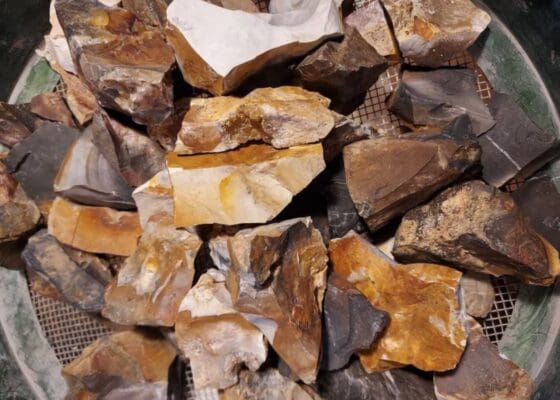
| Gemstone | Description |
|---|---|
| Ohio Flint | The state gemstone, often multi-hued with streaks of white, red, or blue, and was highly valued by Native Americans. |
| Quartz | A widespread mineral that can be found in various forms and colors throughout Ohio. |
| Calcite | Recognizable by its rhombohedral crystal habit and its reaction with hydrochloric acid, often found in limestone. |
| Dolomite | Similar to calcite but does not react as quickly to acid, found in sedimentary basins of Ohio. |
| Galena | A shiny, silver-gray mineral known for its cubic shape, a lead ore that’s occasionally mined in Ohio. |
| Sphalerite | The chief ore of zinc, it can be colorless, yellow, brown, or black and is found in limestone and dolostone. |
| Gypsum | Often found in clear crystals or soft masses, used in plaster and wallboard manufacturing. |
| Feldspar | Found in Ohio’s igneous and metamorphic rocks, it comes in pink, white, or gray. |
| Hematite | An iron oxide mineral, this was once mined as an iron ore in the southern parts of Ohio. |
| Marcasite | Similar in appearance to pyrite but forms different crystal habits, it’s often found in limestone and shale. |
These gemstones, both common and rare, are testimonies to Ohio’s rich geological and cultural legacy. Whether you’re a seasoned collector or a budding geologist, the state promises a treasure trove waiting to be discovered.
Top Gem Mining Locations in Ohio

- Flint Ridge State Memorial, Glenford: A top spot for the famous Ohio Flint, this location beckons to both seasoned and novice miners. Operating from dawn to dusk, there’s a modest fee for digging, ensuring you have ample opportunity to find that perfect piece of Ohio Flint.
- Nelson Ledges Quarry Park, Garrettsville: This quarry park is not only a haven for recreational activities but also a prime location for discovering Quartz and other intriguing minerals. Hours and fees vary, so checking their website before heading out is always a good idea.
- White Star Quarry, Gibsonburg: An old limestone quarry, this spot is known for collecting fossils and minerals alike. While the primary attraction is diving, rockhounding is also popular. Operating hours are from dawn to dusk.
- Hueston Woods State Park, College Corner: Once a hunting ground for Ohio Flint by Native Americans, this park remains a favorite for those in pursuit of the state gemstone. There’s no fee for gem hunting, but park entrance hours apply.
- East Fork State Park, Bethel: Situated along the shores of the East Fork Lake, this park provides opportunities to find geodes, trilobite fossils, and flint. The park is open year-round from 6 a.m. to 11 p.m.
- Caesar Creek State Park, Waynesville: Known for its fossil-rich sites, you can also uncover a variety of minerals here. Fossil hunting requires a permit (which is free), and the park is open from dawn to dusk.
- Seven Springs Gem Mine, Peebles: A popular spot for families, here you can sieve through the sand to uncover quartz, jasper, and even the occasional garnet. Operating hours are seasonal, with fees applicable for the mining kits.
- Auglaize Quarry, Junction: A location favored by seasoned rockhounds, you can find dolomite and calcite crystals here. As this is a functioning quarry, it’s essential to get permission before venturing in.
- Mary Ann Brown Nature Preserve, Logan: Best visited after a rain, the shallow creek beds here are brimming with Ohio Flint. The preserve is open from dawn to dusk with no associated fees for gem hunting.
- Isle Saint George, Lake Erie: This island offers a unique experience, known for its beach glass and rounded, wave-tumbled stones. Ferries are operational during warmer months, with varying hours and fees.
Each of these locations holds its own charm and potential treasures. Whether you’re in it for the thrill of discovery, the connection to nature, or the tangible reward of a found gemstone, Ohio’s mining locations are sure to offer a memorable experience.
History of Gem Mining in Ohio

Gem mining in Ohio is much more than just a modern-day leisure pursuit; it’s a rich tapestry woven through time, capturing the essence of the state’s geological and cultural journey.
Thousands of years ago, long before European settlers set foot on the land, Ohio’s indigenous peoples recognized the value of the state’s minerals. The Native Americans, particularly the Hopewell culture, held the Ohio Flint in high regard. This wasn’t just due to the stone’s vibrant hues and aesthetic appeal, but also its practical utility. Flint, known for its sharp edges when flaked, became an integral part of everyday life. It was skillfully shaped into arrowheads, knives, scrapers, and other tools, playing a pivotal role in hunting, crafting, and warfare. The Flint Ridge area, which today stands as a testament to its importance, was a major extraction and trade center for these indigenous communities.
With the advent of European settlers in the 18th century, Ohio’s mineral wealth began to gain wider attention. Gem mining transformed from being primarily about sustenance and trade among indigenous tribes to an activity of economic significance. Quarries were established, not just for flint but also for limestone, coal, and other minerals, reflecting Ohio’s expanding industrial landscape.
In the 19th and 20th centuries, with the rise of hobbyist collectors and geologists, Ohio’s gem mining scene experienced another shift. It became less about large-scale industrial extraction and more about individual discoveries, education, and recreation. Institutions such as schools, colleges, and local gem and mineral societies started organizing field trips, emphasizing the educational value of hands-on exploration.
Today, while the large quarries and mines primarily focus on resources like coal and limestone for industrial purposes, the legacy of gem mining endures. Enthusiasts and collectors still flock to Ohio’s renowned sites, drawn by the allure of unearthing a tangible piece of the state’s rich geological history. The story of gem mining in Ohio, hence, isn’t just about the stones; it’s about the ever-evolving relationship between humans and the land they inhabit.
Gem Mining Regulations in Ohio

In Ohio, as in many states, the extraction of minerals, including gemstones, is governed by a set of regulations to ensure sustainable practices, protect the environment, and preserve historical and cultural sites. These rules are not just about preserving the state’s geological heritage, but also about ensuring that everyone can enjoy the wonders of gem hunting for generations to come.
To begin with, the distinction between recreational gem hunting and commercial extraction is crucial. For hobbyists and amateur collectors, Ohio offers a multitude of public lands where they can prospect without needing special permissions. However, it’s essential to keep in mind that these activities are typically limited to surface collection. Digging or excavating without permission can lead to penalties.
On private lands, always obtain permission from the landowner before prospecting. It’s not just courteous; it’s the law. Venturing onto private property without consent can be considered trespassing, with associated legal ramifications.
When it comes to commercial extraction, the rules become more stringent. Any entity looking to mine on a larger scale, whether for gemstones, coal, or other minerals, must adhere to Ohio’s mining laws and often requires a permit from the Ohio Department of Natural Resources (ODNR). The ODNR’s Division of Mineral Resources Management is responsible for overseeing all mining activities in the state, ensuring they adhere to environmental standards, safety protocols, and reclamation practices.
Fossil hunting, closely associated with gem mining in many locations, has its own set of rules. For instance, at places like Caesar Creek State Park, while collecting is allowed, you need a free permit to do so, ensuring the activity remains sustainable and doesn’t damage the environment.
Additionally, certain areas in Ohio, especially those of historical or ecological significance, might have restrictions or prohibitions on gem and fossil hunting. Sites like national parks, nature reserves, or historical landmarks often have strict guidelines to protect their unique features and ecosystems.
For those looking to sell their finds, it’s essential to ensure that the gemstones were obtained legally. Selling gemstones from prohibited areas or without the necessary permissions can lead to fines or legal actions.
In conclusion, while Ohio offers a wealth of opportunities for gem enthusiasts, it’s paramount to be informed and respectful. Abiding by state regulations not only ensures a rewarding gem hunting experience but also plays a part in preserving Ohio’s rich geological and cultural heritage for future generations.
Necessary Tools and Equipment for Gem Mining in Ohio
Ohio’s diverse geological landscape presents varied opportunities for gem mining, from sifting through riverbeds to exploring ancient quarries. To maximize success and ensure safety during these explorations, it’s essential to equip oneself with the right tools and gear. Whether you’re a novice or a seasoned gem hunter, this guide will help you navigate Ohio’s terrains with confidence.
1. Screening and Classifying Tools: Reveal those hidden treasures!
Description: Particularly useful when searching along riverbeds or sediment-rich areas, sieves help filter out the larger debris, leaving behind potential gems and minerals. They come in various mesh sizes, allowing for greater specificity in your search.

🛒 Explore Top Screening Sets on Amazon
2. Shovels and Trowels: Digging deep or just scratching the surface?
Description: For those digging in softer grounds or uncovering buried treasures, a sturdy shovel or trowel is essential. These tools are invaluable when attempting to access deeper deposits without disturbing too much of the surrounding environment.

🛒 Find Quality Shovels and Trowels on Amazon
3. Picks and Hammers: The backbone of any gem hunting endeavor.
Description: At the heart of any rockhound’s toolkit is the trusty rock hammer, crucial for breaking open rocks and extracting specimens. Paired with a chisel, it aids in precision work, ensuring minimal damage to the gemstones.

🛒 Check Out Best Picks and Hammers on Amazon
4. Buckets: Your trusted companion for carrying treasures.
Description: Once you’ve unearthed your treasures, you’ll need something to safely transport them. Buckets and containers, preferably with padding, can hold larger finds, while small, sealable bags can store delicate or smaller specimens.

🛒 Shop for Reliable Buckets on Amazon
5. Magnifying Glass: Every detail counts!
Description: To get a closer look at your finds, a magnifying glass or a jeweler’s loupe is essential. It aids in spotting minute details that might distinguish one mineral from another.

🛒 Grab Your Magnifying Glass on Amazon
6. Guidebooks and Field Guides: Knowledge at your fingertips.
Description: Especially for beginners, a field guide to Ohio’s gemstones can be an invaluable companion. Not only does it help in identification but also provides insights into where particular gems might be located.

🛒 Discover the Best Field Guides on Amazon
7. Containers and Bags: Organize, store, and flaunt your finds.
Description: As you collect specimens, having durable bags or containers prevents damage to your finds and makes it easier to carry them.

🛒 Shop for Storage Solutions on Amazon
8. First Aid Kit: Better safe than sorry!
Description: When out in the field, minor injuries can occur. Be prepared with a basic first aid kit, equipped with bandages, antiseptics, and any personal medications.

🛒 Secure Your First Aid Kit on Amazon
Remember, while having the right tools significantly enhances the experience, respecting the environment and adhering to state regulations is paramount. Equipped both in gear and knowledge, your gem hunting expeditions in Ohio are bound to be fruitful.
Tips and Tricks for Successful Gem Mining in Ohio

Embarking on a gem mining adventure in Ohio can be both exhilarating and challenging. To make the most of your expedition and increase your chances of unearthing hidden treasures, consider the following tips and tricks:
1. Research is Key: Before setting out, research your chosen location. Understand its geological history, the types of gemstones it harbors, and any specific rules or regulations. This prep work can provide insights into where and how to begin your search.
2. Time Your Visit: After a rainfall can be an excellent time to search, especially in riverbeds or creeks. Rain can wash away the top layer of sediment, revealing hidden gems. However, ensure the grounds aren’t too muddy or slippery for safety reasons.
3. Start Small: If you’re new to gem mining, begin with surface collection. Walk slowly, scanning the ground, especially around areas with natural erosion. You’d be surprised at what you might find without having to dig.
4. Watch Your Step: Especially in rocky or uneven terrains, be cautious about where you step. Loose rocks can shift, and holes dug by other prospectors can be tripping hazards.
5. Connect with Local Clubs: Joining a local gem and mineral club can be invaluable. Members often share insights, organize group expeditions, and provide hands-on guidance.
6. Learn the Lingo: Familiarize yourself with geological terms, especially those relevant to the gemstones you’re hoping to find. This knowledge can help in deciphering field guides or understanding advice from seasoned rockhounds.
7. Respect the Environment: Always follow the principles of “Leave No Trace.” Refrain from over-digging in one spot, fill in any holes you create, and never remove plants or harm wildlife.
8. Pack Sustainably: Bring enough water and snacks for your trip, but remember to pack out all your trash. Consider using reusable containers to minimize waste.
9. Seek Guidance on Crowded Days: Popular gem mining spots can get crowded, especially during weekends or holidays. If you’re unsure about where to start, watch where seasoned gem hunters are focusing their efforts or strike up a friendly conversation for tips.
10. Stay Patient and Persistent: Gem hunting requires patience. Some days might be bountiful, while others can test your determination. Remember, the thrill of the hunt is as much a part of the experience as the gems you find.
Lastly, gem mining in Ohio is as much about the journey as it is about the destination. The state’s landscapes, its rich geological history, and the simple joy of being outdoors add layers of enrichment to the tangible rewards of your finds. Enjoy every moment, and treasure the memories as much as the gemstones!
Handling Your Gemstone Finds

Once you’ve successfully unearthed gemstones during your Ohio mining expedition, the journey doesn’t stop there. Properly handling, cleaning, and preserving your finds ensures that their beauty and value remain intact. Here’s a comprehensive guide on managing your treasured discoveries:
1. Initial Cleaning: Begin by brushing off any loose dirt or mud with a soft brush. Rinse your gemstones under running water to remove finer particles. For stubborn dirt, soaking the stones in water with a few drops of mild detergent can be helpful.
2. Delicate Handling: Always handle your gemstones with care. Some minerals can be relatively soft and can easily scratch or break. Using soft cloth or padded trays to hold or transport your finds can prevent unnecessary damage.
3. Identification: Before any rigorous cleaning, it’s essential to identify your gemstones. Certain cleaning methods suitable for one stone might damage another. Field guides, local gem and mineral clubs, or expert gemologists can aid in accurate identification.
4. Specialized Cleaning Methods:
- Ultrasonic Cleaners: Suitable for harder gemstones like quartz but can damage porous or fractured stones.
- Acidic Solutions: Helpful for removing iron stains from quartz but can be harmful to other stones and are best used with caution.
- Oxalic Acid: Effective for cleaning rusty stains but requires careful handling and storage away from children and pets.
5. Storing Your Gems: Keep your gemstones in individual soft pouches or compartmentalized boxes to avoid them scratching each other. Store them in a cool, dry place, away from direct sunlight, which can fade some stones over time.
6. Displaying Your Treasures: If showcasing your finds, ensure that the display case or stand provides adequate protection from dust and accidental knocks. Proper labeling with the gem’s name, location of find, and any other relevant details can enhance the display.
7. Valuation: If you believe you’ve found something of significant value, consult a certified gemologist for an appraisal. They can provide insights into the gem’s quality, rarity, and market value.
8. Documentation: Keeping a detailed record of each find – including the date, location, characteristics, and any treatments done – can be invaluable, especially if you decide to sell or trade in the future.
9. Seek Expert Advice: If unsure about any aspect of handling, cleaning, or storing, reach out to professionals or experienced collectors. They can provide guidance tailored to your specific gemstone.
In conclusion, the thrill of discovery doesn’t end once the gem is out of the ground. Properly caring for and cherishing your finds allows you to preserve the magic of that moment, ensuring that the treasures you unearthed in Ohio remain a lasting testament to your gem hunting adventure.
Famous Gemstone Finds in Ohio
Ohio, with its rich geological history, has been a site of numerous significant gemstone discoveries over the years. These finds not only celebrate the state’s abundant natural wealth but have also played pivotal roles in placing Ohio on the mineralogical map. Here are some of the most illustrious gemstone finds in the Buckeye State:

1. Flint Ridge Flint: Flint Ridge, located in east-central Ohio, is known for its stunningly colorful flint. This vibrant, high-quality material was so sought after that indigenous peoples traded it across the continent. The range of colors found in this flint is unparalleled and has made it legendary among collectors.
2. The Giant Celestine Geode: One of the world’s largest geodes, the Crystal Cave on South Bass Island, is a celestine geode measuring over 35 feet in diameter. The dazzling blue celestine crystals within have drawn visitors and researchers from all corners.
3. Isotelus Maximus Trilobite: Discovered in the Cincinnati region, this trilobite fossil, although not a gemstone, is a gem in the eyes of paleontologists. Measuring over a foot in length, it’s one of the largest trilobite specimens ever found.
4. Ohio Pyrite Suns: These disk-like formations of pyrite, also known as pyrite dollars or suns, have a radiant sun-like appearance. They have been discovered in coal mines in the eastern part of the state and are considered rare, making them sought after by collectors.
5. Tremolite from Williamsfield: This unique discovery comprises beautiful green tremolite crystals found in Williamsfield, Ohio. They are cherished for their aesthetic appeal and crystal clarity.
6. The Dundee Dolomite’s Calcite Crystals: From the Silurian age rocks near Sylvania, Ohio, emerged large, lustrous, and well-formed calcite crystals, considered some of the best of their kind.
7. Balancing Gyrolite: In the basalt quarries near Fairport Harbor, gyrolite associated with prehnite and datolite has been found. What’s fascinating is the gyrolite’s ability to balance on a single point.
8. Ohio’s Diamond Find: While diamonds aren’t typical in Ohio, there have been occasional discoveries, one notable find being a 3.5-carat diamond unearthed near the headwaters of Sugar Creek.
The tales of these extraordinary discoveries not only serve to inspire current and future gem hunters but also stand as a testament to Ohio’s geologic grandeur. Each find, whether large or small, adds a chapter to the state’s storied mineralogical history, enriching its legacy for generations to come.
Additional Gem Mining Opportunities

Venturing beyond Ohio’s borders, several neighboring states also offer rewarding gem mining experiences. These states, each with its unique geology, provide a plethora of opportunities to continue your quest for gemstones:
1. Indiana Gem Mining: Indiana, renowned for its geodes filled with sparkling quartz crystals, also offers opportunities to find calcite, dolomite, and pyrite.
2. Kentucky Gem Mining: Delve deep into Kentucky’s earth for agates, especially the Kentucky Blue Agate which is highly sought after by collectors.
3. Michigan Gem Mining: Michigan’s Upper Peninsula is a haven for datolite, copper, agates, and the famous Lake Superior greenstone or chlorastrolite.
4. Pennsylvania Gem Mining: Known for its diverse mineralogy, Pennsylvania boasts quartz crystals, pyrite, garnets, and the state gem, the Pennsylvania jasper.
5. West Virginia Gem Mining: The mountainous regions of West Virginia are a treasure trove for corundum, beryl, and even the occasional diamond.
Exploring these neighboring states broadens the horizon for gem enthusiasts, each offering a distinctive set of minerals and gemstones awaiting discovery. The journey of gem hunting in the American Midwest is vast and filled with potential, making it an ever-enticing endeavor for those passionate about Earth’s hidden treasures.
From locations to tips, everything you need to know about gem mining is in our Gem Mining Near Me guide.
The Magic of Gem Hunting & At-Home Alternatives
Gem hunting in Ohio, with its intertwining threads of history, geology, and adventure, is more than just a hobby; it’s a journey into the very heart of the earth. The Buckeye State beckons with promises of hidden treasures, tales of historic finds, and the sheer thrill of unearthing a gem that has waited millions of years just for you.
However, the allure of gem hunting doesn’t have to be restricted to the vast outdoors of Ohio or its neighboring states. For those who might find traveling a challenge or simply wish to experience the excitement from the comfort of their homes, the Gem Mining Kit offers a splendid alternative. Packed with a diverse array of gemstones waiting to be discovered, this kit brings the magic of gem hunting directly to your doorstep. Whether you’re a seasoned prospector or a curious novice, the world of gemology is vast, exciting, and now more accessible than ever.

